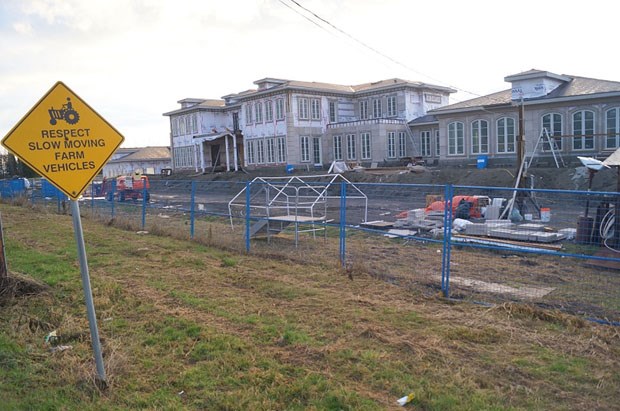The province needs to consider large, multi-generational farm families, says Delta South MLA Ian Paton.
The Liberal agriculture critic said he’s heard from farm families that changes are needed to a bill that would restrict the maximum size of a home on Agricultural Land Reserve property to 5,400 square feet.
Farmland being used by speculators looking to build mansions, without intent of farming the land, has been a hot button issue, especially in Richmond where property owners, for the most part, have successfully lobbied city council not to impose more restrictive limits.
Now that the province has introduced stricter limits, Paton, who is generally supportive of the legislation, said an exception should be added to allow some homes to be built higher on the same footprint.
“I went to a meeting with 400 South Asian farmers who were very, very upset about the home size issue. The main thing is that I’m totally against these mega-homes that they let crop up in Richmond over the years. It’s quite disgusting, 25,000-square-foot homes and bigger situated right in the middle of farms. These are non-farmers,” he told the Optimist.
“What we brought forward as an amendment was an even smaller footprint, so they’d be taking up less farmland with the footprint of the house, then they could go up to three floors above that.
“This is a concern of the South Asian families. A lot of them live differently than we do, they have parents, maybe two families, living and working on the farm. So that’s the important thing, any house that’s going to be a bit bigger has to be legitimately owned by a farmer who’s farming the land, not some wealthy Oriental investor or speculator that’s purchased farmland,” Paton explained.
Noting legitimate farmers can still apply to the Agricultural Land Commission for variances, Agriculture Minister Lana Popham said what Paton is proposing, at the end of the day, is even bigger homes on farmland.
“It was put forward as an amendment but we had been very clear that 500 square metres was the total non-farmers could build on farmland and he (Paton) suggested 350 square metres but to build up, which would actually allow for 700 square metres of living space. We really made the decision that it should be 500 square metres total because of the issue of affordability. We don’t want speculators who aren’t farmers building larger homes and making those farms out of reach for new or young farmers in the future,” Popham said.
“If you’re not a farmer, you’re stuck at 5,400 square feet, and if you are a farmer, and you have multi-generational needs, one of the things we worked on in the legislation over the last year is how do you support those farmers. We’ve created a pathway for those farmers to go to the Agricultural Land Commission to have bigger homes because we recognize sometimes you need bigger homes.
“But that is specifically for farmers who actually support the agricultural production of that land. If you’re a speculator or developer, you’re going to be out of luck with this legislation,” she added. “I don’t know many farming families who would need a 20,000-square-foot home.”
The City of Delta has been well ahead of the game when it comes to stopping mega-homes from being built on ALR land. In 2006, the city set limits to farm home plates on agricultural properties as well as the size of homes that can be built on them.
The maximum farm house floor area for properties less than eight hectares (20 acres) is 3,552 square feet and for properties eight hectares or greater it’s 5,005 square feet. The maximum area for an additional farmhouse is 1,937 square feet on a lot of less than eight hectares, while it’s 2,507 square feet on a lot of eight hectares or greater.
Paton noted something else he wants to see in the government’s legislation is the same requirement by Delta for a farm home plate to be located on the frontage of a property near the road, and in a corner of the farm, avoiding farmland being taken out of service with a house right in the middle of it.



